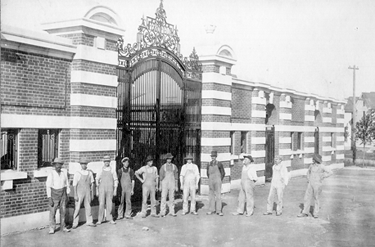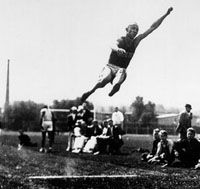Wolverine Origins: The First Stadiums of the Michigan Wolverines
- David Hegler

- Aug 20, 2025
- 5 min read

Some of the most important moments in early college football history happened at the University of Michigan's Regents Field. Later known as Ferry Field, it hosted teams such as Fielding Yost's famed "Point a Minute Men" and was the backdrop for Jesse Owens as he set several national records, bursting onto the national landscape years before he stood up to Adolf Hitler in the Olympics. In time, Ferry Field proved too inadequate and the massive Michigan Stadium was built in its place. This is its story.
Regents Field
It all began one day in 1890 when the University of Michigan Board of Regents set aside $3,000 to purchase a 10 acre parcel of land along South State Street (near where Schembechler Hall stands today) for an athletic field. With an additional $4,500, Michigan set about making the field playable, leveling the surface on the north half of the plot and adding a quarter mile track. Although the grandstand was originally by the east end zone, it was quickly moved to the north sideline so that the meager crowds of 400 the Board of Regents hoped would attend could watch the baseball and football games as well as the track events with ease.
The Wolverine's new field that they simply called "the Athletic Field" opened on October 8, 1892 with Michigan beating the Michigan Athletic Association 74-0. Two years later, the university changed the field's name to Regents Field.

In 1895, the original grandstand burned to the ground and it took the university until May of the following year to gather up the $1,370 necessary for a new grandstand, one twice as large as the original. Soon, tickets were in high demand as the Wolverines became one of college football's earliest dynasties. To accommodate the larger crowds, Michigan erected sets of high open moveable bleachers adjacent to the grandstand that could seat as many as 6,000 people.
In addition to those new moveable bleachers, the Athletic Association also had 1,000 chairs and materials for sloping platforms that could hold an additional 8,000 spectators. That still wasn't enough as bleachers were eventually constructed on the south sideline and the end zones, bringing the capacity up to 15,000. To top it off, a caretakers house was constructed on the suite and a press box was added atop the grandstand. It's been estimated that before the turn of the century, the Athletic Association invested over $12,000 into their ever improving stadium.

Meanwhile, the football team was making strides in the national landscape, fatruing All Americans William Cunningham and Neil Snow along with. aslew of others. In 1904, Michigan beat previously undefeated University of Chicago 22-12 to claim the national championship. With Thomas Edison's cameras rolling, it became the first footage of the game ever filmed. The Wolverines were even better the following year and they were lights out on defense, shutting out every opponent except the very last one. The University of Chicago beat them 2-0 to end an otherwise perfect year.
The Board of Regents had seen enough. The turnstiles never seemed to stop turning that year as Michigan drew record crowds to Regents Field, including 17,000 in a 12-0 win over Wisconsin in mid November. While the increased revenue was good, the school's leaders knew that space was limited. So, naturally, they turned to a botanist.
Ferry Field

Detroit businessman, Dexter Ferry, had supported a botany group on the Michigan campus for years and grew enamored with the school's athletic program. In 1902, he donated a plot of land just north of Regents Field and the athletic field was promptly renamed in his honor. After several smaller purchases that stretched the property all the way to the train tracks on the west, the recently renamed Ferry Field was 38 acres strong. A far-cry from its initial 10 acre plot.
Ferry Field's newly built walls were designed by Detroit architect Albert Kahn and was made of Bedford stone, red paving prick and wrought iron gates. The north bleachers could fit as many as 9,0000 and came complete with a covered press box on the top row. Some Regents Field bleachers that could seat roughly 6,000 were moved to the south side line and temporary bleachers were moved to the west end zone to raise capacity to 18,000

Drainage tile helped sop up the notoriously soggy field and the Ann Arbor Railroad donated 10,000 yards of sand and gravel to fill the low spots that dotted the weathered field. With six inches of fresh top soil to thicken the. turf, Ferry Field was ready for action when it opened for play on October 6, 1906. Fullback John Garrellis scored the first touchdown in the new stadium's history and was phenomenal as a punter all day long as the Wolverine cruised to a 28-0 win over Case.
Meanwhile, the university never stopped improving the venue. Seeing how both teams had to use the facilities in nearby Waterman Gym a mile across campus, in 1912 Detroit architects Smith, Hinchman and Grylls designed a state-of-the-art locker room at the east end zone that quickly became the envy of athletes all across America. Designed after an old English clubhouse, the building featured dressing rooms for both teams, offices, lecture rooms and a lounge area, costing the school $37,000. Today, that building is now known as the Marie Hartwig Building.
In 1914, the old wooden bleachers along the south sideline were replaced with a unique set of concrete bleachers. The 55 rows were designed so that everyone of the 13,000 attendees should have at least four inches of clear views from above the person in front of them. The first 11 rows had nine inch risers, the second set of 11 rows had 10 inch risers and so on.
Although the Board of Regents discussed transforming Ferry Field into a horseshoe shape that was all the rage at the time, it never truly came to be. Still, the school kept adding to its beloved stadium, including a set of wooden bleachers in 1921 to fully enclose the stadium on the west end. Its final capacity reached a peak of 42,000 when the school added temporary bleachers by the east end zone.
All of these improvements came in handy over the years as Michigan continually hosted big games and heroic players. 50,000 crammed into the venue in 1923 as Michigan beat arch rival Ohio State 23-0 and crowds averaging 48,000 flocked to watch the country's first quarterback-receiver tandem of Bennie (Friedman) to Bennie (Oosterbaan, the school's first three time All American) in 1926.
Michigan dominated in their 21 years at Ferry Field, going 90-13-2 and winning the national championship in 1918 and 1923 while going 5-2-1 against the hated Buckeyes. While the football team moved to the Big House in 1926, the university still used Ferry field as a track venue, providing a splendid backdrop for Jesse Owens in 1935 as the sophomore track phenom broke world records in the 220 dash, the broad jump, the 22 yard low hurdles and tying a 100 yard dash record.

Ferry Field still exists today, but times have changed. With the addition of new athletic facilities for track and field, the site now adjacent to the Intramural Building serves as a valuable tailgating space for football fans, many of whom have no idea how historic that site once was.
References



Comments